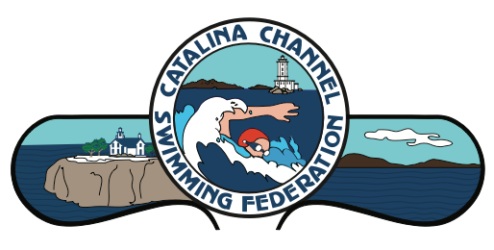Challenges of Catalina
FIVE CHALLENGES OF CATALINA CHANNEL
While training for a Catalina Channel attempt, swimmers must consider how they intend to approach FIVE CHALLENGES that test an athlete’s stamina and courage.
Each year, we witness swimmers make an unsuccessful attempt because they have not properly prepared. Some of these athletes overestimated their skills but underestimated these five challenges:
CHALLENGE ONE: DISTANCE
The Catalina Channel is a little more than 20-miles at its shortest distance. A training program must be tailored so that the swimmer can travel that distance in open water, and possibly a few more miles due to currents. Swimmers are encouraged to complete a non-stop swim that exceeds 15-miles. (Every practice swim is training for the first mile, the second mile, and so forth. The question to ask yourself, if you’ve never swum this distance, is how will you train for miles 18, 19, 20, and beyond?)
CHALLENGE TWO: TEMPERATURES
Temperatures fluctuate in the Channel from one day to the next. Surface temperatures will change throughout the day – colder in the morning and warm under the afternoon sun. Also, we regularly see warmer water near the island.
Often, the temperature will drop dramatically, as much as 10 degrees Fahrenheit (or 5 degrees Celsius) in the 3 miles nearest the California mainland.
We’ve watched strong and experienced swimmers enter this portion of the crossing and simply crumble, physically as well as mentally, as the temperature tumbled. Hypothermia is a serious issue, and a common cause for swimmers to stop short of their goal.
Therefore, a swimmer must become acclimated to cold water immersion for long periods of time. Fatigue, hydration, stress and lack of sleep can all contribute to the onset of hypothermia.
The CCSF Official Observers always place safety first and pull swimmers who demonstrate signs of advancing hypothermia.
CHALLENGE 3: NAUSEA
Before the swim begins, it is a two-hour boat ride to reach Catalina Island. Seasickness must be avoided during this trip. Nausea often incapacitates an athlete.
Any crew member, and in particular the swimmer and companion swimmers, must take precautions against seasickness.
The sailors say there are two stages to seasickness: First, you feel so ill that you fear you will die. Then, you feel so sick that you fear you might not.
CHALLENGE 4: MIDNIGHT START
A midnight start – to avoid the blustery afternoon winds — requires several hours of nighttime swimming. For the fastest swimmers, the majority of their crossing may occur in complete darkness, when vision is impaired and depth perception is compromised.
Successful swimmers will have practiced several times at night for many miles, learning how to navigate with glow sticks as your only guide. Few places are as dark as swimming in the open ocean at night and a dozen miles from any shoreline.
Some athletes become disoriented while enveloped in this blackness where the horizon disappears and both sea and sky merge. Vertigo and nausea are common complaints from swimmers and will compromise any attempt.
CHALLENGE 5: CURRENTS
Currents are unpredictable and can be swift. The vast majority of Catalina crossings occur during neap tides, when it is believed the tidal currents will be minimal. Still, the Channel surface is influenced by ocean currents which impact every speed of swimmer but particularly the slower athletes.
There’s no predicting when or where these surface currents will appear. Experienced swimmers have been stymied and slowed by currents to the point that they endured 50% longer in the water than their predicted time. Every Channel swimmer will tell you that swimming along the shoreline in no way approaches the difficulty you can find out in the Channel.
How will you train for these FIVE CHALLENGES?—
Distance, Hypothermia, Currents, Seasickness, and Night Swimming.
- Our recommendation is to work with an experienced open water coach and train as much as possible under Channel conditions.
- This means cold open water swims, adjacent to a kayak or escort vessel, for long distances, hydrating with endurance fuels.
- Endurance fuels are a personal choice. Never rely solely on another person’s recommendation. You need to discover which fluids you like and what your body will tolerate. You will want a fuel that tastes good to you – especially deep into a swim after your tongue is swollen and your mouth feels raw.
- Hydration is typically more important than calories during a Channel swim so reach first for liquid endurance fuels— skip the gels and chewy bars. Or make them your secondary choice. Water must always be consumed.
- You feed every 15 to 30 minutes while training and in the Channel.
- Many swimmers have spent years building up to the endurance level necessary for a Catalina Channel crossing. They started with open water swims, graduated to 10k races, and eventually tested their limits on longer & longer events in cold water that mimics the Channel conditions.
- The corollary is that every season the Catalina Channel Swimming Federation sees swimmers who dream of making an attempt without the necessary experience. But very early in the training process, they cancel their swim application and boat contract after a jolt of knowledge that they lack the skills to make a crossing. Or sudden injury due to overuse.
- Night training swims, under the guidance of a safety navigator such as a kayak, are essential to success. We would recommend more than one, well after sunset, and during the same moon phase of your attempt.
- Consider training swims based on time spent in the water as compared to the distance traveled. Your successful 20 mile crossing may take significantly longer than you predict.
- Successful swimmers arrive with a plan and an experienced team of supporters, who are familiar with the swimmer’s fuels & feeding process, their moods swings, and personality. Some swimmers become quiet, others easily agitated, while other swimmers are chatty during the feeds.
- Hypothermia is a serious risk during any cold water swim. A Channel swimmer must practice as much as possible in water that approaches the expected temps. Acclimation requires prolonged exposure to Catalina Channel temps which range between 58 and 72 degrees (14 and 22 Celsius).
- Swimmers can help delay the onset of hypothermia using a few tested techniques which are allowed by the Catalina Channel Swimming Federation. Earplugs are helpful, though they hamper the swimmer’s ability to communicate with the support team.
A silicone cap, as compared to latex, provides additional insulation. So does adding an extra layer of body fat while you’re cold water acclimatizing. Many cold water swimmers exhale the warm air from their lungs through the nose to apply constant heat to their face and head. Finally, some swimmers opt for their fuels to be warmed on the boat.
Part of the mission of the Catalina Channel Swimming Federation is to advise swimmers in advance of your attempt. Please address your questions to info@swimcatalina.org . This e-mail address is being protected from spambots. You need JavaScript enabled to view it.
Please consider consulting the Marathon Swimmers Forum to learn more from open water swimmers.
FORMS

